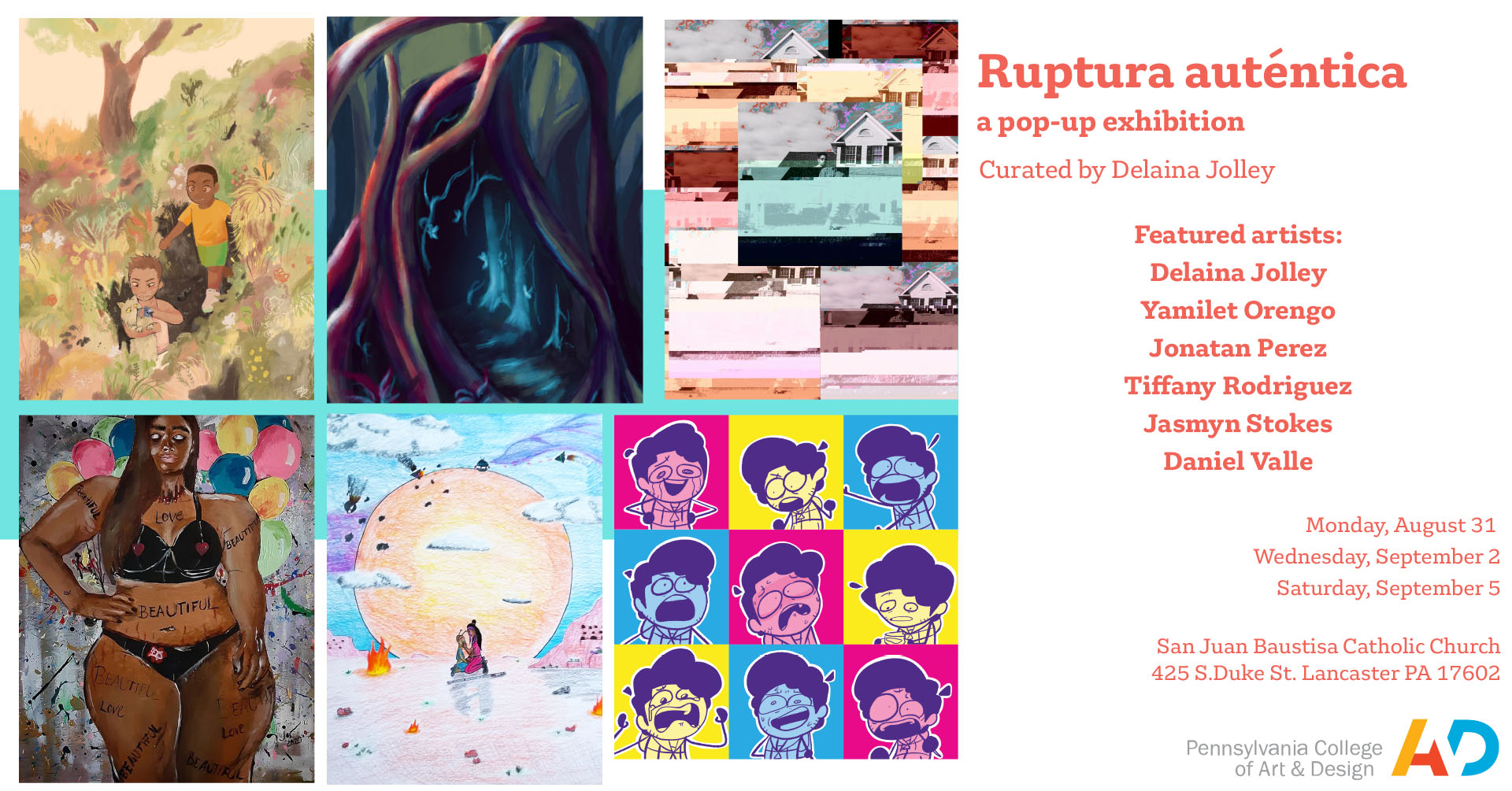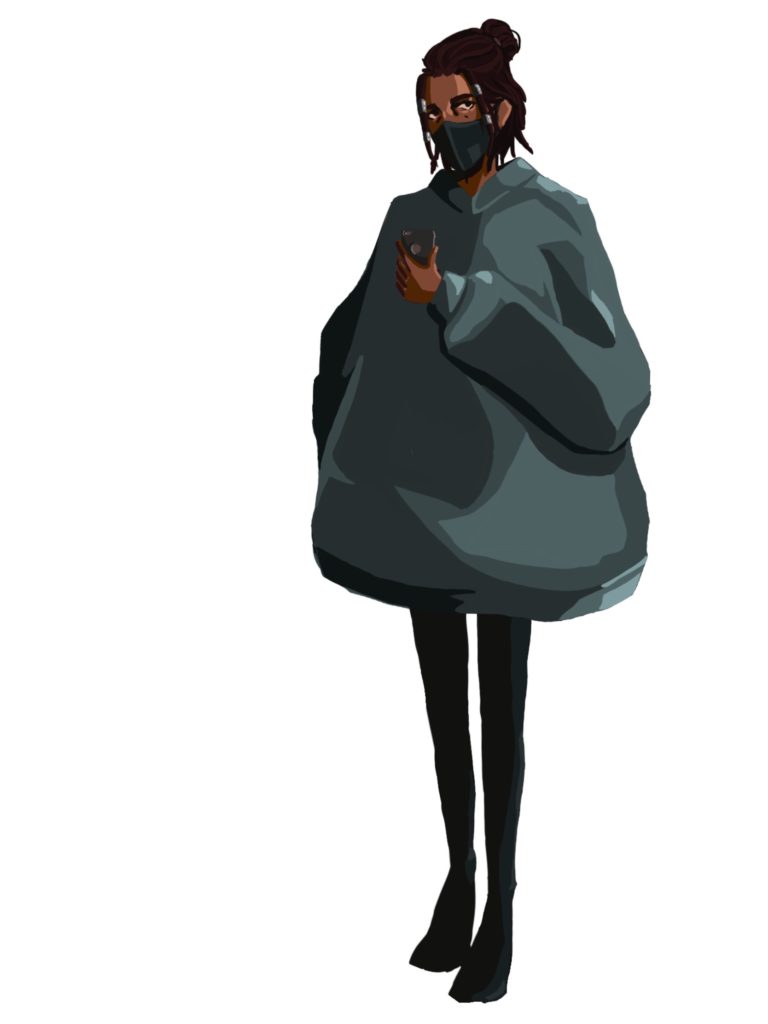
Ruptura auténtica pop-up exhibition highlights 6 Latinx PCA&D artists
Wednesday, August 26th, 2020
The annual Hispanic Festival at San Juan Bautista Catholic Church is a vibrant 37-year tradition, a celebration of culture and music and food and heritage — and all the ways they tie together into something inseparable.
This year, a pop-up exhibition by PCA&D, Ruptura auténtica, adds art to that mix.
Curated by Delaina Jolly ’22, Illustration, Ruptura auténtica brings the work of six emerging Latinx artists before a wider audience. Over three days, the art of Yamilet Orengo ‘22, Jonatan
Perez ’23, Tiffany Rodriguez ‘19, Jasmyn Stokes ‘23, Daniel Valle ‘24, and Jolley will be on display, exploring concepts of sorrow, anxiety, serenity, relationships, and identity.
Take a look with curator Jolley at how Ruptura auténtica has evolved:
When setting out to create this exhibition, what were your goals? How did you hope this body of work, when organized collectively, would impact viewers?
Delaina Jolley: I want this exhibition to provide the community with a sense of calmness. I desire viewers to see this exhibition and allow themselves to let their emotions be free for a little while. With everything going on today, including some time in our days to just reflect on ourselves is really important. For the Latinx community, I hope this exhibit helps spark positive conversations surrounding mental health.
The festival runs Aug. 31 through Sept. 5, and the exhibition will be on display select dates during the festival: Monday, Aug. 31, 5-7 pm; Wednesday, Sept. 2, 5-7 pm; Saturday, Sept. 5, 11 am to 1 pm and 5-7 pm, weather permitting. You can find more information here. San Juan Bautista is within walking distance of campus; you can find directions here.
Are there any concepts and understandings you hope to convey?
DJ: I hope to convey that the emotions that we have been feeling during this unprecedented time are valid and not easy to express through words.
Have you uncovered particular issues, motifs, or ideas explored by these artists? What are the common threads?
DJ: I find that each artist in Ruptura auténtica balances their practice with artworks representing both positive and negative emotions.
Did you choose to arrange the works within the threads of commonality you found between the artists? if so why?
DJ: I chose to arrange the works in a way that shows a journey. I think at the beginning of the pandemic (when we had to lock down in quarantine) a lot of us were upset, but it was more than just sorrow. We had a mindset that it wouldn’t get so bad if we just worked together. Throughout the summer, things haven’t been getting better, but we are starting to adapt. I want the artwork to resemble that.
How does the placement contribute to the meaning behind the artworks?
DJ: I think that when we look at each work within this arrangement, certain emotions are invoked that aid in the understanding of each work individually. We can all relate because we have all experienced similar emotions.
What strategies did you use to develop a relationship between the artwork and the viewer?
DJ: I think enclosing the artwork in a space where the viewer is guided to follow the emotional journey in a certain way will help show that not only are we all experiencing this pandemic similarly, but how it’s important to confront our emotions.
How do the arrangement and presentation choices you made support the relationship and connections between the artworks presented?
DJ: Each art piece tells a unique story, but aside from the thematic connections I’ve found that the color palettes align with each other in a way that helps them create a connection or a sense that they belong together.
What do you aspire for viewers to take away from visiting Ruptura auténtica as a pop-up exhibition at the Annual Hispanic Festival?
DJ: I hope people take the time to explore each emotion they experience while viewing the exhibition. Whether it is subtle, or if a section of the exhibition really brings out a strong reaction in them. I want them to learn that what they’re feeling is OK and that we’re all going through them together.
How is being an artist in the exhibit a challenge when you are organizing an exhibition as a curator?
DJ: It’s challenging because I have to look at my work as an observer rather than the creator. I have to focus on artworks that will help push the narrative of this exhibition and not just works that are my favorites.
What do you believe is the strongest aspect of this exhibition?
DJ: Variety. I think the fact that each artist has a different style in Ruptura auténtica is the strength of the exhibit. Some artists manipulate media and others paint. It shows that we’re all different, but the emotions that are invoked are what bring us together.

